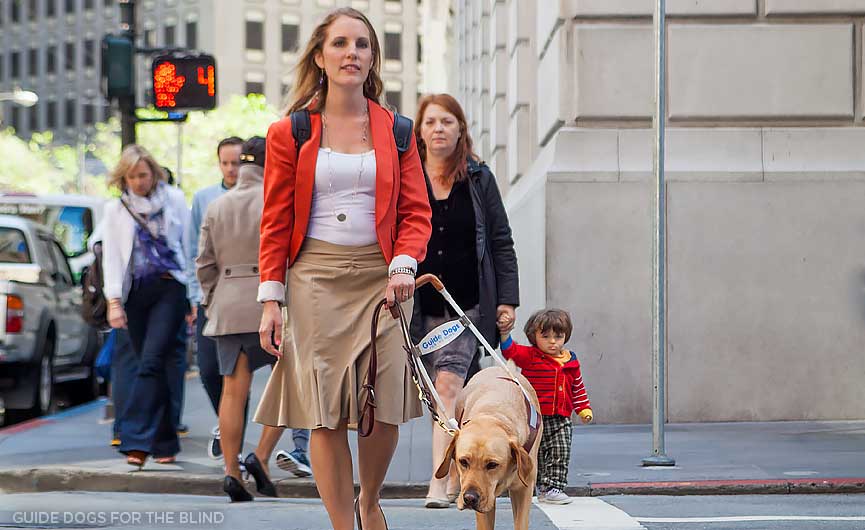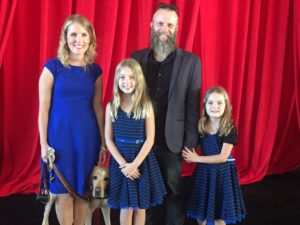
OCTOBER IS NATIONAL DISABILITY EMPLOYMENT MONTH (NDEAM). HERE’S WHAT EVERYONE SHOULD KNOW ABOUT THE VALUE DIFFERENTLY ABLED PEOPLE BRING TO THE WORKPLACE.
I recently returned to the field of education after an eight-year stay-at-home-mom hiatus. In addition to the typical reentry jitters and pondering over whether my favorite coral blazer is still in style, some more significant questions surfaced as I signed my contract: How will I travel to trainings and meetings after the closest bus routes to my house were just cut? What if one of my students or parents is allergic to my guide dog? And how many sessions with my accessibility specialist will it take for me to confidently use all the technology required to do my job?
As a person who is legally blind, these are legitimate questions to ask, but they’re also relatively straightforward to solve, especially when compared to the invisible barriers people with disabilities face.
The concerns that kept me awake the nights preceding my first day of new-teacher training were far more nuanced than transportation hiccups. My mind darted anxiously from cultural stigma to past experiences to potential perceptions, but it ultimately landed on this one question: At this organization, will I be valued for what I can bring or overlooked for what I lack?
As an educator with significant sight loss, I’ve had several work-related situations cause me to pause and wonder how to proceed.
In my early 20s, after my very first teaching job interview, the principal said the reason he wasn’t hiring me was that my eyes sometimes drifted to the sides instead of looking right at him. I later found out my student-teaching supervisor had called him to say how well I’d done with the eighth graders, explaining that my vision loss didn’t affect my ability to teach. She told him about the system I’d developed for calling on students though I couldn’t see their raised hands, and how I was so in tune with my three language arts classes that I made each of my 90 students an individualized certificate listing their unique gifts at the end of my 16 weeks with them. The principal still chose not to hire me. Neither did the principal at the school where I student taught. Fortunately, a principal in a nearby town was able to look past my disability and hired me to teach seventh grade language arts.
Yet consistent positive reviews in my first few years of teaching failed to shield me from others’ doubts. One behavioral specialist didn’t want to place her student in my classroom because she was afraid I wouldn’t keep a close enough “eye on him,” despite that he had an aide who would be there most days. While the student participated well in my class overall, I began to sense that his aide was focused on scrutinizing my ability to do my job rather than on helping this student. Thankfully this was not the sentiment of all my coworkers. I felt supported and valued as a team player by most. But an undercurrent of dissent can poison a sea of supporters when you’re feeling watched and pressured to prove yourself.
Fast-forward to last spring when I began applying for jobs after my mommy-hiatus: I was surprised to find that an element of discrimination still exists, at least in the hiring processes of several places in Southern California. The director of a local academy, for example, asked me how I was able to teach with my limited sight. I felt my throat tighten at the bluntness of her inquiry and tried to maintain focus as her hiring assistant sat next to her, sighing heavily throughout the interview, stating at the end of our conversation, “I really doubt we have a place for you here.” I debated not bringing my cane or guide dog into my next interview but worried I would appear intoxicated if I fumbled to sit down.
Thinking I’d have a better chance gaining employment at a local institute for the blind and visually impaired, I applied for a position as an instructor after noting that I met all the position’s qualifications. In my cover letter, I highlighted my active involvement within the blind and visually impaired community and how I have mentored others experiencing vision loss. I was disappointed when I didn’t get an interview or any written response at all, after multiple attempts to follow up on my application. When I expressed this to a friend who is blind and volunteers at the institute, she told me, “Oh, you shouldn’t have said you’re visually impaired in the cover letter. They don’t really hire people with low vision very often. Mostly just as volunteers but rarely as paid teachers.”
Right about now, anyone versed in disability law is raising a hand to comment, ready to point out that a seemingly small action, like asking someone directly about their disability during a job interview, is illegal and could even be grounds for a court case. I do realize this, but sitting in a courtroom just doesn’t seem like the best use of my time and energy. This is not to say others shouldn’t involve legal action in certain cases of work-related discrimination. I have friends who’ve had to fight to keep their jobs after losing vision, and I wholeheartedly support their efforts.
According to recent statistics, 17.5% of people with disabilities were employed in 2015, compared to 65% employment among persons without disabilities. I am convinced that at least a portion of those remaining 82.5% desire to work but are unable to cross barriers into the workplace.
As I continued my own job search, I remembered an interaction I had at an Apple store in Chicago a couple of years ago. I was asking about voiceover on my iPhone, and the technician became stumped over a couple of my questions. He apologized and said he’d check with his coworker, an expert in voiceover who used it all the time. “He’s blind and teaches all of us new tricks on voiceover,” he added. His statement gave me a sense of pride for some reason, like the technician without sight wasn’t some employee who everyone had to help but someone who brought unique, needed expertise. Simply hearing about this employee reminded me that I, too, have unique expertise to offer.
Being a credentialed teacher, not a techy, I knew finding a cutting-edge school would be more difficult than finding a trending tech company. Yet the explosion of new charter schools in California offered a large pond from which to fish, one that ultimately led me to my current position with an innovative charter school.
Since those in leadership typically set both the tone and precedent for interactions among coworkers, I was immediately impressed by how my director conversed with me about my needs. She offered her assistance and support if needed but didn’t hover or seem concerned. Not once has she asked me how I’ll keep up with paperwork, travel to meetings or learn the detailed technology component of my position. Not once has she asked me how I’ll do my job. She hasn’t asked me because she’s focused on something far more important than my disability: what I can bring to her team.
While it requires openness, hiring someone with a disability is hardly an act of charity. Yes, incorporating someone who is differently abled often entails accommodations, extra meetings or time in training for both the new hire and others within the organization. There are potential risks and real barriers, but there are also real benefits.
People with disabilities are accustomed to finding alternative solutions to difficult questions, because troubleshooting is part of our daily lives. There are strengths I bring to my position because of, not in spite of, my vision loss. I relate with students who are struggling in a way that others may not, and I will not cease searching for the unique ways students show their intelligence, not just the traditional ones our education system deems important.
When an organization offers someone the opportunity to bring their talents, skills and knowledge to the table, they will absolutely show up and thrive. Giving a differently abled person the chance to excel in what they are skilled at not only allows that individual to succeed, but it also promotes a culture of perseverance among everyone. When I watch my students progress in their learning journey despite challenges, I feel motivated to move forward in my own educational discoveries. And when an organization hires and values qualified employees who are differently abled, the organization sends a resounding message to its team and to the public: “Here, we care about what each employee uniquely brings.” Or, as stated simply in the words of my favorite poet, Maya Angelou: “In diversity there is beauty and there is strength.”
 I have been leading these meetings for the past month, and I have moments where I think “holy cow, I’m doing it!” I’m sharing my screen, moving seamlessly through Google Docs, and using technology in ways that felt impossible a couple months ago.
I have been leading these meetings for the past month, and I have moments where I think “holy cow, I’m doing it!” I’m sharing my screen, moving seamlessly through Google Docs, and using technology in ways that felt impossible a couple months ago.







